The Landscape of Provence
Unlike
the Impressionists, who painted numerous scenes of city life, Cezanne never
felt at home in Paris. He returned to his native Provence to find the
inspiration which eluded him in the capital.
Paul
Cezanne began his painting career at a time when the artistic world was firmly
focused on Paris. The early Impressionists all studied there, and even when
they travelled into outlying villages, or to the coast of Normandy, they still
returned repeatedly to the capital to exhibit and attempt to sell their
paintings. But Cezanne, shy and socially inept, was never really suited to
Parisian life. During the eight years he spent there, from 1863 to 1870, he was
happier wandering alone in the hills outside the capital than drinking and
debating with the urbane, avant-garde artists of the Café Guerbois.
THE MOUNTAINS AND THE SEA
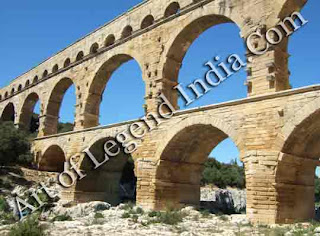 When
the Prussian army invaded France in 1870, Cezanne returned south to his home
town of Aix-en-Provence partly to avoid conscription. The environment he found
there was not only more familiar, but offered an atmosphere totally opposite to
the metropolitan sophistications of Paris. Instead of the grey chill of the
northern winter there was dazzling sunlight and warmth for most of the year;
instead of narrow cobbled streets there were massive granite mountains,
fast-flowing rivers and the blue Mediterranean Sea; instead of jostling crowds
and short-lived fashions there was solitude, a slow pace of life and a
reassuring sense of timelessness.
When
the Prussian army invaded France in 1870, Cezanne returned south to his home
town of Aix-en-Provence partly to avoid conscription. The environment he found
there was not only more familiar, but offered an atmosphere totally opposite to
the metropolitan sophistications of Paris. Instead of the grey chill of the
northern winter there was dazzling sunlight and warmth for most of the year;
instead of narrow cobbled streets there were massive granite mountains,
fast-flowing rivers and the blue Mediterranean Sea; instead of jostling crowds
and short-lived fashions there was solitude, a slow pace of life and a
reassuring sense of timelessness.
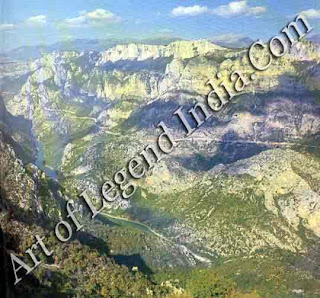
The
landscape of Provence became one of the principal inspirations of Cezanne's
work. He painted it with a relentless intensity that few artists have devoted
to any subject, creating dozens of images of favourite motifs, above all the
Mont Sainte-Victoire. In 1886 he wrote to the collector Victor Chocquet, 'there
are treasures to be taken away from this country, which has not yet found an
interpreter equal to the abundance of riches which it displays', and 30 years
later, a few weeks before his death, he was still so entranced with the
landscape that he wrote to his son: 'I think I could occupy myself for months
without changing my place, simply bending a little more to left or right.' Yet
the hundreds of paintings and drawings Cezanne produced of Provence tell us
little about the region. He concentrated on the underlying, unchanging
structure of the landscape, and did not usually represent a particular time of
day or even a particular season. There is nothing anecdotal about his pictures
and they usually contain no figures or other evidence of human activity. Houses
are often included, but they are treated as part of the landscape, and he never
painted the town of Aix itself.
AN INDEPENDENT PEOPLE
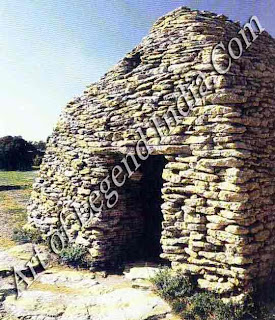 Some
400 miles from Paris, isolated from the north by the Alps and the rugged
plateau of the Massif Central, Provence was like a separate country in
Cezanne's day. Rail links with the north, only recently completed, had done
little to break down an attitude of sturdy independence that dated back to Roman
times, when the region first earned its name as 'Provincia Romana'. Nor had the
lifestyle of its inhabitants changed greatly over the centuries a description
by the Roman fl historian Posidonius remained as true in the 19th century as
the day it was written in the 1st century BC: The country is wild and arid. The
soil is so stony that you cannot plant anything without striking a rock.' The
population had remained largely rural, with peasant agriculture the mainstay of
the economy.
Some
400 miles from Paris, isolated from the north by the Alps and the rugged
plateau of the Massif Central, Provence was like a separate country in
Cezanne's day. Rail links with the north, only recently completed, had done
little to break down an attitude of sturdy independence that dated back to Roman
times, when the region first earned its name as 'Provincia Romana'. Nor had the
lifestyle of its inhabitants changed greatly over the centuries a description
by the Roman fl historian Posidonius remained as true in the 19th century as
the day it was written in the 1st century BC: The country is wild and arid. The
soil is so stony that you cannot plant anything without striking a rock.' The
population had remained largely rural, with peasant agriculture the mainstay of
the economy.
Provence's
stormy history had, if anything strengthened its differences from the rest of
France. After the Romans, the Barbarians, Franks, Saracens and Normans all left
their bloody mark upon the region, attracted by its strategic position between
Spain and Italy at the mouth of the River Rhone. Right up until the time of the
French Revolution it was rare for Provence to enjoy long periods of peace or
stability. But the Revolution was welcomed by the southerners, who believed it
would lead to more independence from the 'Parigots', as they contemptuously
called those from the capital. It was in Marseilles that the French national
anthem the Marseillaise first rang out in 1792. Three years before, the red,
white and blue national flag known as the tricolour was raised in the small
Provencal town of Meringues.
Even in
Cezanne’s time, the inhabitants of Provence maintained a strong sense of
regional pride, underpinned by the local dialect, impenetrable to outsiders.
Cezanne sometimes used it in the Café Guerbois when he wished to be pointedly
anti-social. However, this traditional language was diminishing in use, as the
'standard' Parisian dialect became obligatory for those engaged in commerce. To
try to stop the decline, a poet called Frederic Mistral, with seven other
Provencal literary figures, formed a society in 1854 'to rise up, honour and
defend the mother tongue, now so sadly despised and neglected'. The campaign
was enthusiastically received and the society's review L' Armana Prouvencau
(the Provencal Almanac) became fashionable reading, but it could not reverse
the steady decline in everyday use of the language.
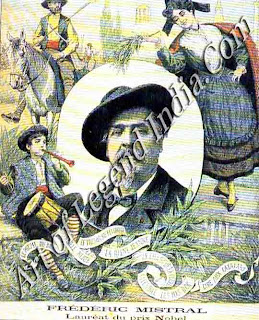
Although
time seemed to have stood still in many parts of Cezanne's Provence, changes
were occurring on the coast that was to transform the region's image, as the
Riviera became a luxurious holiday playground. The fashion for staying there
was started by Lord Brougham, Lord Chancellor of England, who had to stay in
Cannes in 1834 during a cholera outbreak which delayed his intended journey
into Italy. He liked it so much that he returned regularly for the next 30
years. Monte Carlo became probably the most famous of the resorts associated
with conspicuous high-living, and its celebrated casino opened in 1861.
A HAVEN FOR ARTISTS
Although
the railway linked Aix with Cannes and Nice, Cezanne was more attracted to the
coastline nearer home especially the village of L'Estaque, of which he painted
some memorable pictures. The scenery around L'Estaque was renowned for its
beauty, as Zola's description testifies: 'A village just outside of Marseilles,
in the centre of an alley of rocks which close the bay. . . The country is
superb. The arms of rock stretch out on either side of the gulf, while the
islands, extending in width, seem to bar the horizon, and the sea is but a vast
basin, a lake of brilliant blue when the weather is fine.
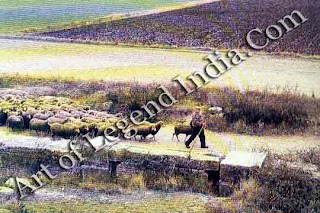 Although
Cezanne was the first painter to make the Provencal landscape a major subject
of his work, he was not the only great artist of his period to be attracted to
the region. Van Gogh lived at Arles from 1888 to 1890, and was visited .f there
by Gauguin in 1888. Van Gogh had intended forming an artists' colony at Arles,
and although this came to nothing, the fact that he and the other two founding
figures of modern art worked in Provence has, from the early 20th century,
played a part in luring other artists there. Most of the major figures who have
worked there have been drawn to the Cote d'Azur in the east of the region.
Matisse is particularly associated with Nice, and Picasso with Antibes; Renoir
built a villa at Cagnes towards the end of his long life.
Although
Cezanne was the first painter to make the Provencal landscape a major subject
of his work, he was not the only great artist of his period to be attracted to
the region. Van Gogh lived at Arles from 1888 to 1890, and was visited .f there
by Gauguin in 1888. Van Gogh had intended forming an artists' colony at Arles,
and although this came to nothing, the fact that he and the other two founding
figures of modern art worked in Provence has, from the early 20th century,
played a part in luring other artists there. Most of the major figures who have
worked there have been drawn to the Cote d'Azur in the east of the region.
Matisse is particularly associated with Nice, and Picasso with Antibes; Renoir
built a villa at Cagnes towards the end of his long life.
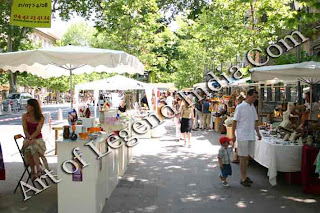
Provence
today is proud of its artistic heritage. Antibes has a Picasso museum, for
example, and Nice has museums devoted to both Chagall and Matisse. Yet the home
town of Provence's greatest artist cannot boast any important examples of his
work. Cezanne's studio in Aix (in a street that has been renamed the Avenue
Paul Cezanne) is open to the public, but the Musk. Granet in Aix has only a few
minor paintings and drawings among its predominantly classical collection of
paintings from the 16th to the 19th centuries. The director in Cezanne's day
was an arch-conservative who vowed that no Cezanne would ever hang there so
long as he had power to prevent it.
Auguste
Henri Pointier kept his word until his death in 1926, by which time Cezanne's
master-pieces had been dispersed around the globe. Yet in one way this is not
inappropriate, for Cezanne was committed to the enduring and universal values
of his landscape rather than its topographical details. His genius belongs to
the world, not just one particular place.
Writer
– Marshall Cavendish
 When
the Prussian army invaded France in 1870, Cezanne returned south to his home
town of Aix-en-Provence partly to avoid conscription. The environment he found
there was not only more familiar, but offered an atmosphere totally opposite to
the metropolitan sophistications of Paris. Instead of the grey chill of the
northern winter there was dazzling sunlight and warmth for most of the year;
instead of narrow cobbled streets there were massive granite mountains,
fast-flowing rivers and the blue Mediterranean Sea; instead of jostling crowds
and short-lived fashions there was solitude, a slow pace of life and a
reassuring sense of timelessness.
When
the Prussian army invaded France in 1870, Cezanne returned south to his home
town of Aix-en-Provence partly to avoid conscription. The environment he found
there was not only more familiar, but offered an atmosphere totally opposite to
the metropolitan sophistications of Paris. Instead of the grey chill of the
northern winter there was dazzling sunlight and warmth for most of the year;
instead of narrow cobbled streets there were massive granite mountains,
fast-flowing rivers and the blue Mediterranean Sea; instead of jostling crowds
and short-lived fashions there was solitude, a slow pace of life and a
reassuring sense of timelessness.  Some
400 miles from Paris, isolated from the north by the Alps and the rugged
plateau of the Massif Central, Provence was like a separate country in
Cezanne's day. Rail links with the north, only recently completed, had done
little to break down an attitude of sturdy independence that dated back to Roman
times, when the region first earned its name as 'Provincia Romana'. Nor had the
lifestyle of its inhabitants changed greatly over the centuries a description
by the Roman fl historian Posidonius remained as true in the 19th century as
the day it was written in the 1st century BC: The country is wild and arid. The
soil is so stony that you cannot plant anything without striking a rock.' The
population had remained largely rural, with peasant agriculture the mainstay of
the economy.
Some
400 miles from Paris, isolated from the north by the Alps and the rugged
plateau of the Massif Central, Provence was like a separate country in
Cezanne's day. Rail links with the north, only recently completed, had done
little to break down an attitude of sturdy independence that dated back to Roman
times, when the region first earned its name as 'Provincia Romana'. Nor had the
lifestyle of its inhabitants changed greatly over the centuries a description
by the Roman fl historian Posidonius remained as true in the 19th century as
the day it was written in the 1st century BC: The country is wild and arid. The
soil is so stony that you cannot plant anything without striking a rock.' The
population had remained largely rural, with peasant agriculture the mainstay of
the economy.  Although
Cezanne was the first painter to make the Provencal landscape a major subject
of his work, he was not the only great artist of his period to be attracted to
the region. Van Gogh lived at Arles from 1888 to 1890, and was visited .f there
by Gauguin in 1888. Van Gogh had intended forming an artists' colony at Arles,
and although this came to nothing, the fact that he and the other two founding
figures of modern art worked in Provence has, from the early 20th century,
played a part in luring other artists there. Most of the major figures who have
worked there have been drawn to the Cote d'Azur in the east of the region.
Matisse is particularly associated with Nice, and Picasso with Antibes; Renoir
built a villa at Cagnes towards the end of his long life.
Although
Cezanne was the first painter to make the Provencal landscape a major subject
of his work, he was not the only great artist of his period to be attracted to
the region. Van Gogh lived at Arles from 1888 to 1890, and was visited .f there
by Gauguin in 1888. Van Gogh had intended forming an artists' colony at Arles,
and although this came to nothing, the fact that he and the other two founding
figures of modern art worked in Provence has, from the early 20th century,
played a part in luring other artists there. Most of the major figures who have
worked there have been drawn to the Cote d'Azur in the east of the region.
Matisse is particularly associated with Nice, and Picasso with Antibes; Renoir
built a villa at Cagnes towards the end of his long life. 
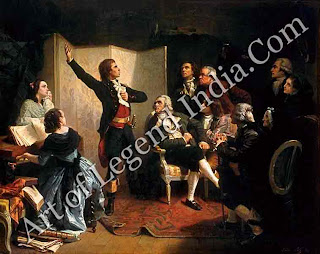













0 Response to "French Great Artist Paul C'ezanne - The Landscape of Provence "
Post a Comment